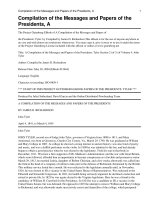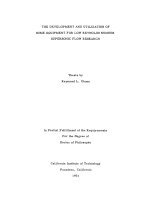Extension of the storage and post-storage life of tuberose (Polianthes tuberosa L.) loose flowers cv. ‘local’
Bạn đang xem bản rút gọn của tài liệu. Xem và tải ngay bản đầy đủ của tài liệu tại đây (1.16 MB, 10 trang )
Int.J.Curr.Microbiol.App.Sci (2018) 7(1): 2798-2807
International Journal of Current Microbiology and Applied Sciences
ISSN: 2319-7706 Volume 7 Number 01 (2018)
Journal homepage:
Original Research Article
/>
Extension of the Storage and Post-Storage Life of Tuberose
(Polianthes tuberosa L.) Loose Flowers cv. ‘Local’
Parag Babaji Jadhav* and Nikhil Pradip Gurav
Agril Research Expert and Agri. Res. Asso., Ecofrost Technologies Pvt. Ltd., Survey No 134/1,
134/2,130/3, Jeevan Nagar, Tathawade, Pune, Maharashtra-411 033, India
*Corresponding author
ABSTRACT
Keywords
Tuberose, Loose,
Sucrose, GA3, Silver,
STS, Storage Life,
Flower, Ecofrost, Local,
Cold, etc.
Article Info
Accepted:
20 December 2017
Available Online:
10 January 2018
The present trial was carried out at Yavat, District Pune, Maharashtra, India
– 412214 during the month of October 2017. The aim of this study was to
examine the effect of two treatments on the storage life and the post-storage
life of Tuberose loose flowers cv. „Local‟. The 2 treatments applied
consisted of spraying of GA3 @ 50 ppm + Sucrose @ 1% + Silver
Thiosulphate (STS) @ 50 ppm (T2) along with control (T1). Storage life of
these flowers was higher with treatment T2 than the treatment T1, while
kept inside cold storage at 40C with 93% RH. Post-storage life was also
higher with T2 than in control (T1).
Introduction
Tuberose is grown commercially in many
countries including India, Kenya, Mexico,
Morocco, France, Italy, Hawaii, South Africa,
Taiwan, North Carolina, USA, Egypt, China
and many other tropical and subtropical areas
in the world. In India, commercial cultivation
of Tuberose is popular in Bagnan, Kolaghat,
Midnapur, Panskura, Ranaghat, Krishnanagar
of West Bengal; Coimbatore and Madurai
districts of Tamil Nadu; Pune, Nashik,
Ahmednagar, Thane, Sangli of Maharashtra;
East Godavari, Guntur, Chitoor, Krishna
District of Andhra Pradesh; Mysore, Tumkur,
Kolar, Belgaum and Devanhalli taluka in
Karnataka; Guwahati and Jorhat in Assam;
Udaipur, Ajmer and Jaipur in Rajasthan;
Navsari and Valsad of Gujarat and parts of
Uttar Pradesh and Punjab. As per area and
production statistics of the National
Horticulture Board ( the
total area under Tuberose cultivation in the
country is about 7.95 lakh hectares. The
production of loose and cut-flowers is
estimated to be 27.71 „000 MT‟ and 1560.70
lakh (nos) respectively ( />agriculture/cropproduction/packageofpractices
/flowers/tuberose#section-25, 2013). In India,
Tuberose is a very popular flower and millions
upon millions of spikes are sold every year.
2798
Int.J.Curr.Microbiol.App.Sci (2018) 7(1): 2798-2807
Tuberose flowers are cultivated to produce
flower spikes and loose flowers on a
commercial scale for the domestic market.
The Tuberose flowers are cultivated
throughout the year and can be grown outdoor
or under greenhouse conditions. The variety of
flowers grown has also increased dramatically.
Tuberose flowers are in demand for their
elegant attractive spikes of different hues.
Tuberoses can be easily grown with a little
care and attention in beds for garden
decoration and cut flowers in pots for interior
and outdoor decoration.
in shade and then were put inside the cold
storage. 3 crates of loose flowers (7kg loose
flowers/crate) of Tuberose cv. “Local” were
treated with light spray of the solution of [GA3
@ 50 ppm + Sucrose @ 1% + Silver
Thiosulphate (STS) @ 50 ppm] (T2) and then
first crate was placed at normal room
conditions to measure the shelf life (days),
second crate was placed in cold room for 8
hours to measure the pre-cooling life (days)
and third crate was also placed at cold room to
check the storage life (days) of the
commodity.
Tuberose loose flowers are very sensitive to
the stress of storage and transportation,
particularly at warm temperatures. There are
reports that improper post-harvest handling
accounts for 20% to 30% of cut-flower loss
during marketing. While production of highquality flowers is important, it is equally
critical to handle the flowers properly after
they are harvested from the field.
1 kg of flowers were taken out from the third
crate inside the cold room on day 1 (just after
treatment of flowers), at the end of day 1, at
the end of day 4, at the end of day 6, at the end
of day 9 and at the end of day 12 to check the
post storage life (days) in ordinary room
conditions.
Materials and Methods
The present trial was carried out in the cold
storage of Ecofrost Technologies Pvt. Ltd at
the site of farmer, District Pune, Maharashtra,
India – 412 214 during the month of October
2017. The aim of this study was to examine
the effect of a combination of GA3 @ 50 ppm
+ Sucrose @ 1% + Silver Thiosulphate (STS)
@ 50 ppm along with control on the postharvest storage-life of tuberose loose flower
cv. „Local‟. The 2 treatments applied were
tagged as T1 and T2 i.e. spray of GA3 @ 50
ppm + Sucrose @ 1% + Silver Thiosulphate
(STS) @ 50 ppm (T2) along with control (T1).
The stage of separation of Tuberose loose
flower depends on the distance from the
market, where the flowers are to be sold. It is
always preferable to separate the loose flowers
in the morning hours. Immediately after
separation, loose flowers were kept for 30 min
Three crates of loose flowers (7kg loose
flowers/crate) of Tuberose cv. “Local” were
treated with light spray of tap water (T1) and
out of them, the first crate was placed at room
conditions to measure the shelf life (days), the
second crate was placed inside the cold room
for 8 hours to measure the life (days) after precooling and the third crate was also placed
inside the cold room to check the storage life
(days) of commodity.
1 kg of flowers were taken out from the third
crate from cold room on day 1 (just after
treatment of flowers), at the end of day 1, at
the end of day 4, at the end of day 6, at the end
of day 9 and at the end of day 12 to check the
post storage life (days) in ordinary room
conditions.
Observations recorded
The post-harvest shelf-life of loose flowers
(days) at normal room conditions, storage life
(days) inside cold room and the post-storage
2799
Int.J.Curr.Microbiol.App.Sci (2018) 7(1): 2798-2807
life (days) at room conditions were observed
during the month of October 2017.
Results and Discussion
Photos were taken in cold storage
Post-storage life was recorded as 12 days for
treated Tuberose loose flowers (T2) stored at
40C + 93% RH. However, only 9 days was
recorded in control (T1) (Table 1 and Graph
1). After pre-cooling, storage life was
recorded as 2.5 days for treated Tuberose
loose flowers (T2) kept at room conditions.
Only 2.00 days was recorded in control (T1)
(Table 2 and Graph 1). Normal shelf life
(days) of Tuberose loose flower was recorded
as 1.50 days at room condition (T1) (Table 3).
Likewise, 2 days was recorded in T2.
Table.1 Storage life (days) of Tuberose loose flowers cv., „Local‟ inside the cold room
(Ecofrost Technologies Pvt. Ltd., Pune)
Treatment Details
Set points
Tuberose loose flowers (Control-T1)
Tuberose loose flowers (With treatment-T2)
40C + 93% RH
40C + 93% RH
Cold storage life
(Days)
9.00
12.00
Table.2 Pre-cooling life (days) of Tuberose loose flowers cv. „Local‟ in ordinary room
conditions, after produce held inside the cold room conditions for 8 hours
Treatment Details
Tuberose loose flowers (Control-T1)
Tuberose loose flowers (With treatment-T2)
Precooling set point
for Tuberose loose
flowers
0
4 C + 93% RH
40C + 93% RH
Pre-cooling life
(Days) in ordinary
room conditions
2.00
2.50
Table.3 Shelf-life (days) of Tuberose loose flowers cv. „Local‟ in ordinary room conditions
Treatment Details
Shelf life (Days) in ordinary room
conditions
1.50
2.00
Tuberose loose flowers (T1)
Tuberose loose flowers (T2)
Table.4 Post-storage life (Days) of Tuberose loose flowers cv. „Local‟ in ordinary room
conditions
On days flowers were taken out from cold
storage and put at room conditions
1st day (at initial start point)
At end of 1st day
At the end of 4th day
At the end of 6th day
At the end of 9th day
At the end of 12th day
2800
Post-storage life
(Days) at room
conditions (T1)
1.50
2.00
2.00
1.50
1.00
0.50
Post-storage life
(Days) at room
conditions (T2)
2.00
2.50
2.50
2.00
1.50
1.00
Int.J.Curr.Microbiol.App.Sci (2018) 7(1): 2798-2807
Photo.1 1st Day Photos (09-10-2017) (T1- Tap water spray)
Photo.2 4th Day Photos (12-10-2017) (T1-Tap water spray)
Photo.3 6th Day Photos (14-10-2017) (T1-Tap water spray)
2801
Int.J.Curr.Microbiol.App.Sci (2018) 7(1): 2798-2807
Photo.4 1st Day Photos (T2)
Photo.5 4th Day Photos (T2)
Photo.6 6th Day Photos (T2)
2802
Int.J.Curr.Microbiol.App.Sci (2018) 7(1): 2798-2807
Photo.7 T1 (Tap water spray): Un-treated flowers were taken out on 09-10-2017 from cold storage & put at room conditions. Photos
were taken at the end of day 1, 2 & 3
Day-I
Day-II
Day-III
Photo.8 T1-(Tap water spray): Un-treated flowers were taken out on 12-10-2017 from cold storage & put at room conditions. Photos
were taken at the end of 8 hours, 1st day & 2nd day
After 8 hours
Day-I
2803
Day-II
Int.J.Curr.Microbiol.App.Sci (2018) 7(1): 2798-2807
Photo.9 With treatment (T2): Treated flowers were taken out on 09-10-2017 from cold storage & put at room conditions. Photos were
taken at the end of 1st, 2nd& 3rd day. (Flowers treated with spray of mixture solution- GA3 @ 50 ppm + Sucrose @ 1% + Silver
Thiosulphate (STS) @ 50 ppm)
Day-I
Day-II
Day-III
Photo.10 With treatment (T2): Treated flowers were taken out on 12-10-2017 from cold storage & put at room conditions. Photos
were taken at the end of 8 hours, 1stand 2nd day. (Flowers treated with light spray of mixture solution- GA3 @ 50 ppm + Sucrose @
1% + Silver Thiosulphate (STS) @ 50 ppm)
After 8 hours
Day-I
2804
Day-II
Int.J.Curr.Microbiol.App.Sci (2018) 7(1): 2798-2807
Graph.1 Storage and Post-storage life (Days) of Tuberose Loose Flowers Cv. 'Local'
Graph.2 Tuberose loose flowers cv. „Local‟ post-storage life (Days) at room conditions
2805
Int.J.Curr.Microbiol.App.Sci (2018) 7(1): 2798-2807
Graph.3 Tuberose loose flowers cv. „Local‟ post-storage life (Days) at room conditions
On days flowers were taken out from the cold room and put inside ordinary room conditions
(T1)
In table 4 (Graph 2 and 3), post-storage life
(days) was recorded higher in T2 (chemical
solution treated flowers) than control (T1-tap
water treated flowers). Withering of petals
(untreated flowers) started on day 1.5 at room
conditions, after loose flowers were taken out
from cold room at the end of day 6. Similarly,
withering of petals (treated flowers) started on
day 1.5 at room conditions, after these were
taken out from cold storage at the end of day
9. Petal drying started inside cold room after
end of the 11 days in storage for the untreated
flowers (T1) and after end of the 14 days for
the treated flowers (T2). Photo No. 1 to 6
show untreated and treated flowers inside the
cold storage and Photo No. 7 to 10 show
flowers taken out from the cold storage and
kept in room conditions. None of the disease
signs were recorded inside cold storage for
treated flowers. Treated and untreated flowers
were stored for more than 16 days, but the
post storage life was recorded less than 6 hrs
in normal room conditions.
The addition of sugars in spray solution is
essential for good flower development
(Paulin, 1986). Sucrose feeding of loose
flower causes an acceleration of enzyme
activity and proline accumulation in the petals
at the end of the vase-life. Recently, it has
been suggested that in stress situations cells
require more sugars to fulfil the energy and
carbon needs for the defensive response to
stress (Koizuka et al., 1995). Since, the cutflowers suffer from energy deficiency and are
susceptible to different stresses, the demand
for hexoses in petals might be satisfied
partially by the hydrolysis of starch.
Moreover, according to (Tirosh and Mayak,
1988), the activity of α-amylase plays an
important role in the mechanism of petal
opening and regulates the senescence
syndrome.
From the above discussion, it can be
concluded that shelf life of Tuberose cv.
„Local‟ loose flowers was higher withT2 (light
2806
Int.J.Curr.Microbiol.App.Sci (2018) 7(1): 2798-2807
spray of GA3 @ 50 ppm + Sucrose @ 1% +
Silver Thiosulphate (STS) @ 50 ppm (10ml
per kg loose flowers)) than control T1 (10ml
tap water per kg loose flowers) at room
conditions. Similarly, storage life was higher
in cold storage (40C + 93% RH) with T2 than
T1. Post-storage life (days) was also recorded
high in T2.
References
/>f
/>
n/packageofpractices/flowers/tuberose#
section-25, 2013.
Koizuka N, Tanaka Y, and Morochashi Y.
Expression of α-amylase in response to
wounding in mung bean. Planta, 1995;
195:530–534.
Paulin, A. 1986. Influence of exogenous
sugars the evolution of some senescence
parameters
in
plants.
Acta
Horticulturae, 1986; 181:183–193.
Tirosh T, and Mayak S. Changes in starch
content during the development of
carnation petals. Journal of Plant
Physiology, 1988; 113(3), 361–363.
How to cite this article:
Parag Babaji Jadhav and Nikhil Pradip Gurav. 2018. Extension of the Storage and Post-Storage
Life of Tuberose (Polianthes tuberosa L.) Loose Flowers cv. „Local‟.
Int.J.Curr.Microbiol.App.Sci. 7(01): 2798-2807. doi: />
2807









